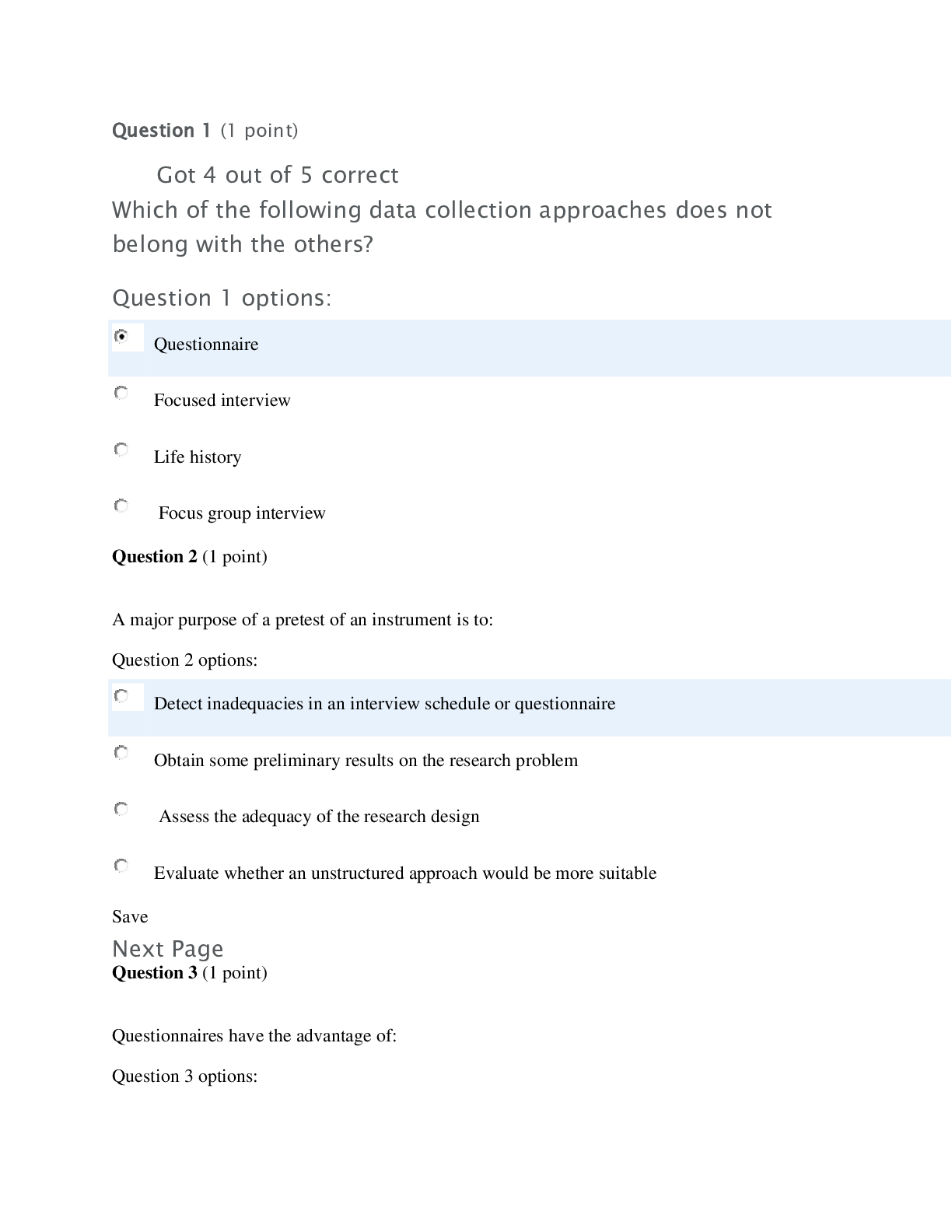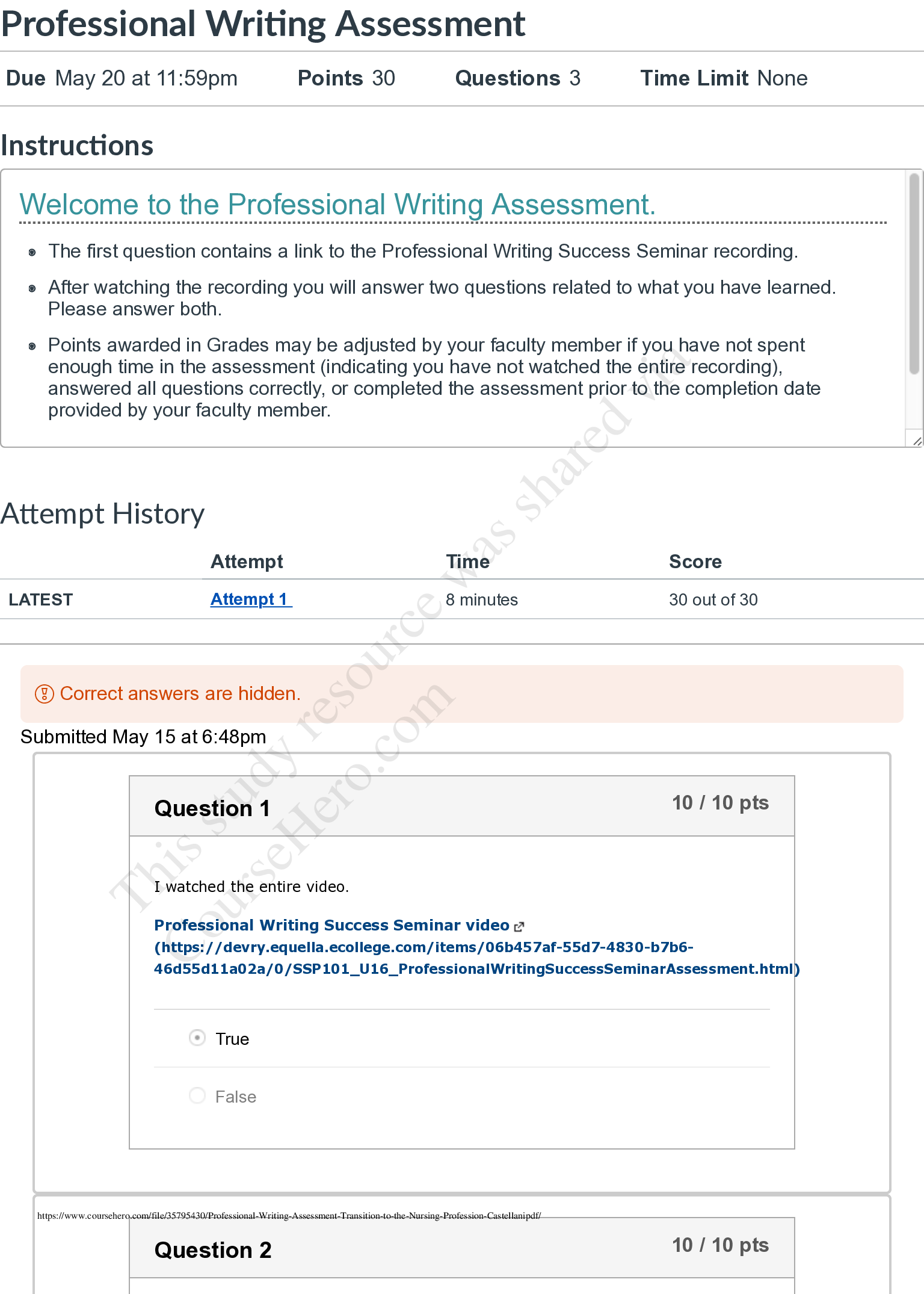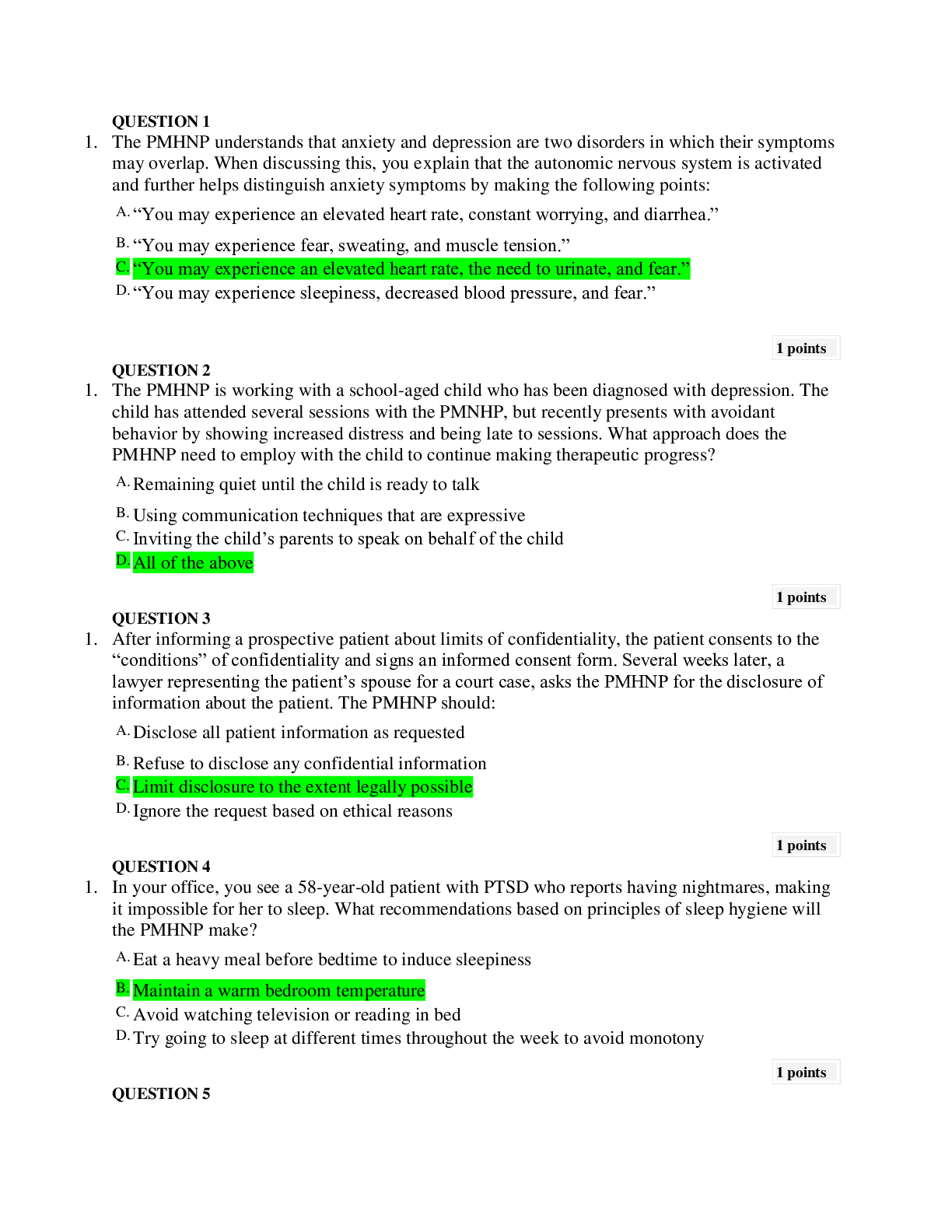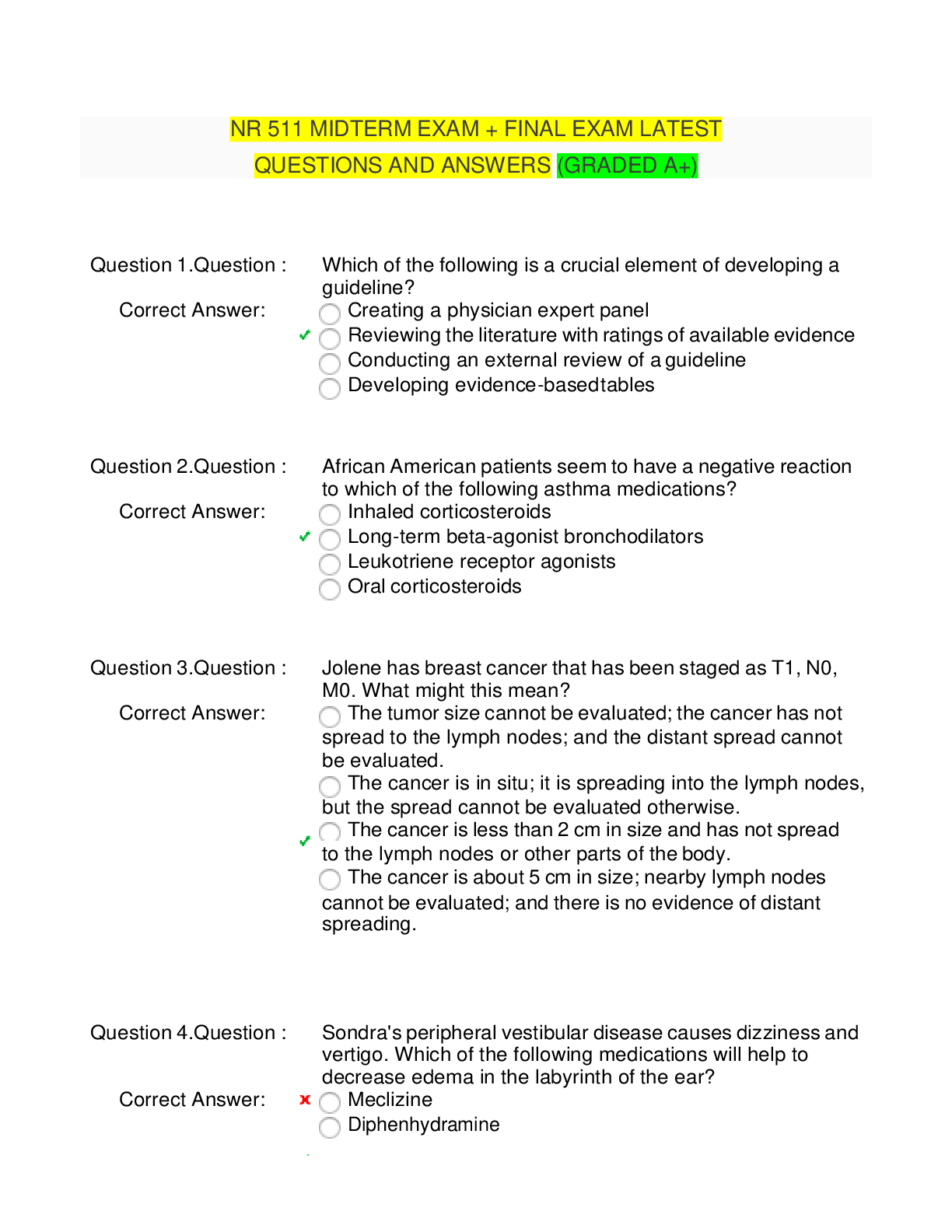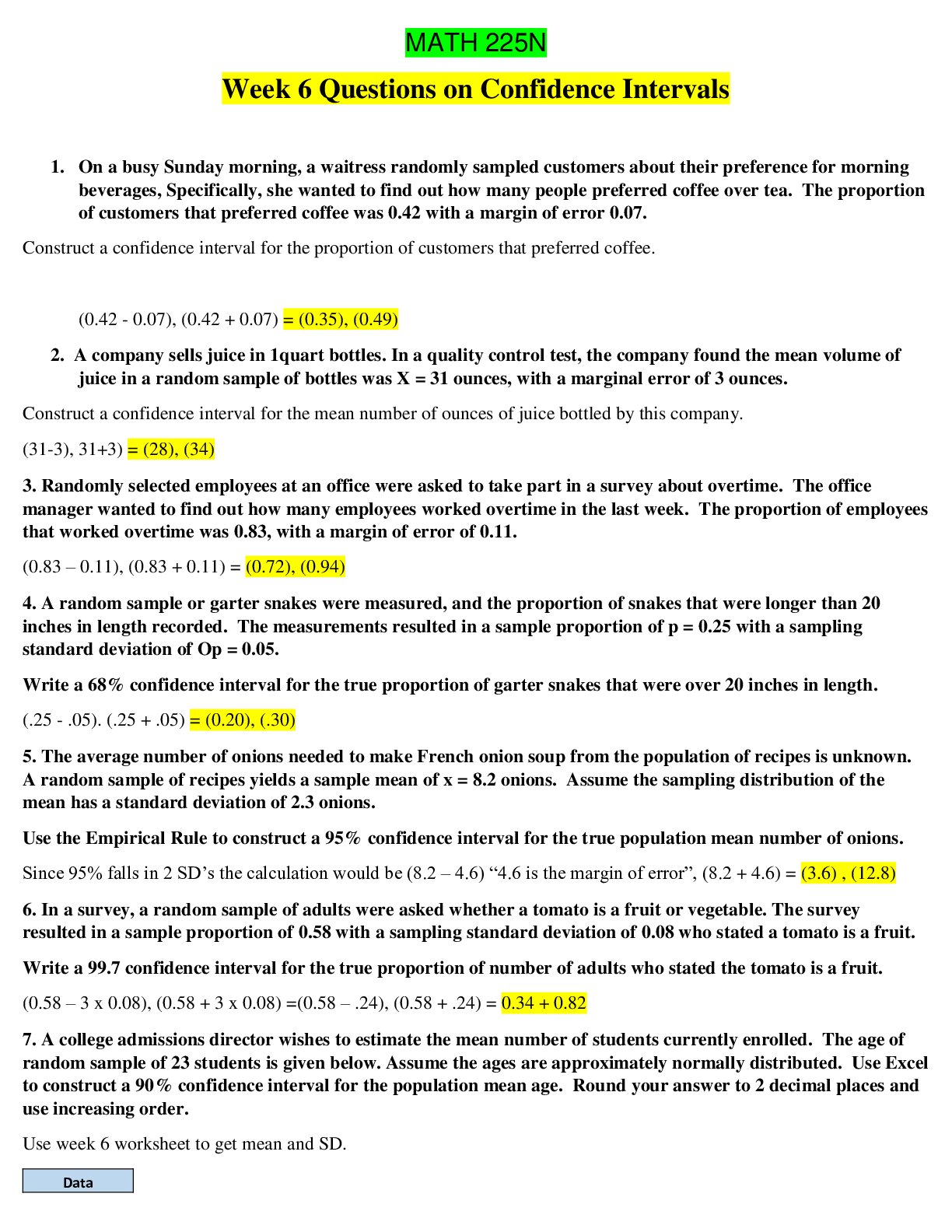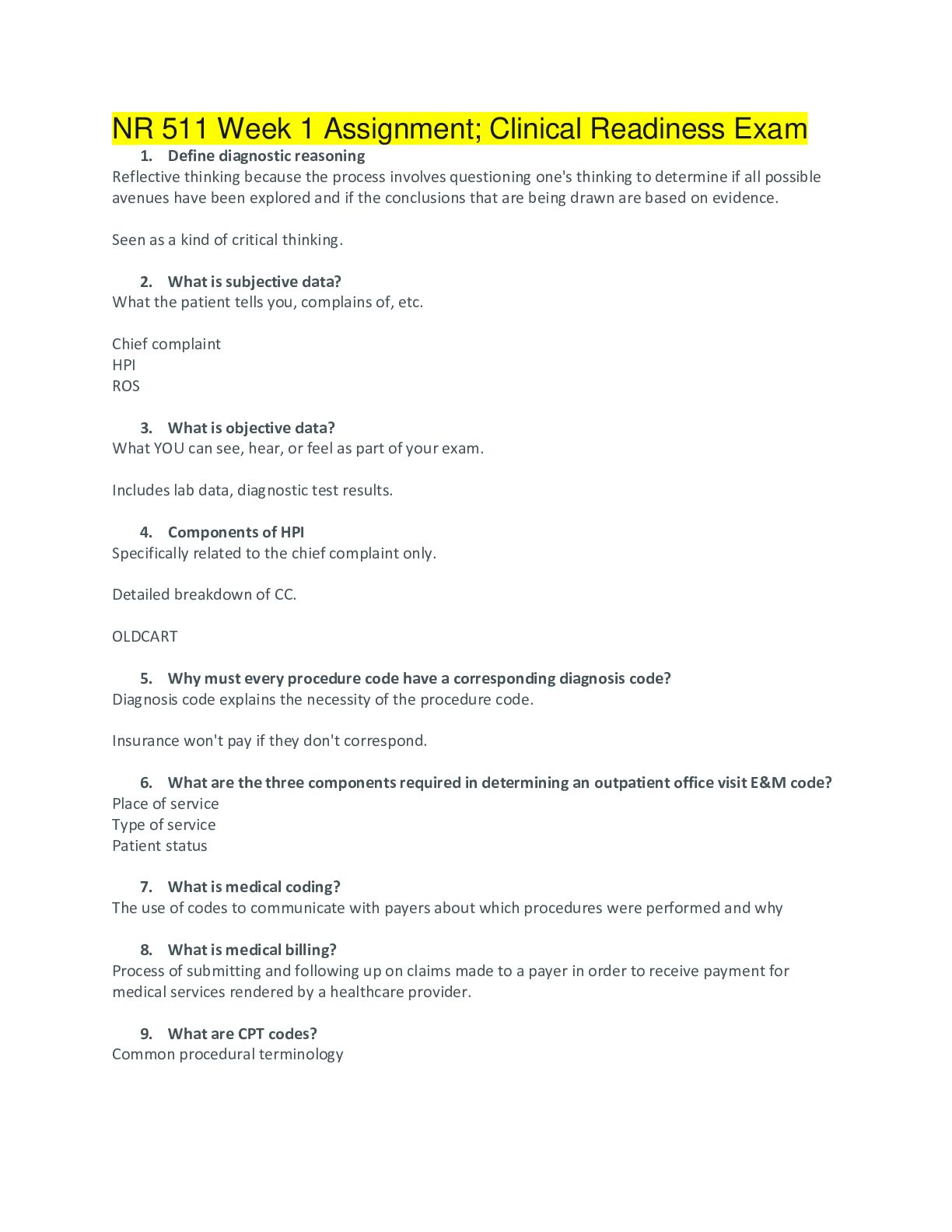NCLEX PRACTICE EXAM 3 PRACTICE QUESTIONS AND ANSWERS (WITH EXPLANATIONS)
Document Content and Description Below
NCLEX Practice Exam 3 Question 1 A patient is admitted to the hospital with a diagnosis of primary hyperparathyroidism. A nurse checking the patient’s lab results would expect which of the follow... ing changes in laboratory findings? Question 2 A patient with Addison’s disease asks a nurse for nutrition and diet advice. Which of the following diet modifications is NOT recommended? . Question 3 A patient with a history of diabetes mellitus is on the second post-operative day following cholecystectomy. She has complained of nausea and isn’t able to eat solid foods. The nurse enters the room to find the patient confused and shaky. Which of the following is the most likely explanation for the patient’s symptoms? Question 4 A nurse assigned to the emergency department evaluates a patient who underwent fiberoptic colonoscopy 18 hours previously. The patient reports increasing abdominal pain, fever, and chills. Which of the following conditions poses the most immediate concern? . Question 5 A patient is admitted to the same day surgery unit for liver biopsy. Which of the following laboratory tests assesses coagulation? (Select all that apply) Question 6 A nurse is assessing a clinic patient with a diagnosis of hepatitis A. Which of the following is the most likely route of transmission? . Question 7 A leukemia patient has a relative who wants to donate blood for transfusion. Which of the following donor medical conditions would prevent this? Question 8 A physician has diagnosed acute gastritis in a clinic patient. Which of the following medications would be contraindicated for this patient? Question 9 The nurse is conducting nutrition counseling for a patient with cholecystitis. Which of the following information is important to communicate? Question 10 A patient admitted to the hospital with myocardial infarction develops severe pulmonary edema. Which of the following symptoms should the nurse expect the patient to exhibit? Question 11 A nurse caring for several patients on the cardiac unit is told that one is scheduled for implantation of an automatic internal cardioverter-defibrillator. Which of the following patients is most likely to have this procedure? Question 12 A patient is scheduled for a magnetic resonance imaging (MRI) scan for suspected lung cancer. Which of the following is a contraindication to the study for this patient? Question 13 A nurse calls a physician with the concern that a patient has developed a pulmonary embolism. Which of the following symptoms has the nurse most likely observed? . Question 14 A patient comes to the emergency department with abdominal pain. Work-up reveals the presence of a rapidly enlarging abdominal aortic aneurysm. Which of the following actions should the nurse expect? Question 15 A patient with leukemia is receiving chemotherapy that is known to depress bone marrow. A CBC (complete blood count) reveals a platelet count of 25,000/microliter. Which of the following actions related specifically to the platelet count should be included in the nursing care plan? Question 16 A nurse in the emergency department is observing a 4-year-old child for signs of increased intracranial pressure after a fall from a bicycle, resulting in head trauma. Which of the following signs or symptoms would be cause for concern? Question 17 A nonimmunized child appears at the clinic with a visible rash. Which of the following observations indicates the child may have rubeola (measles)? Question 18 A child is seen in the emergency department for scarlet fever. Which of the following descriptions of scarlet fever is NOT correct? Question 19 A child weighing 30 kg arrives at the clinic with diffuse itching as the result of an allergic reaction to an insect bite. Diphenhydramine (Benadryl) 25 mg 3 times a day is prescribed. The correct pediatric dose is 5 mg/kg/day. Which of the following best describes the prescribed drug dose? Question 20 The mother of a 2-month-old infant brings the child to the clinic for a well-baby check. She is concerned because she feels only one testis in the scrotal sac. Which of the following statements about the undescended testis is the most accurate? Question 21 A child is admitted to the hospital with a diagnosis of Wilms tumor, stage II. Which of the following statements most accurately describes this stage? Question 22 A teen patient is admitted to the hospital by his physician who suspects a diagnosis of acute glomerulonephritis. Which of the following findings is consistent with this diagnosis? Note: More than one answer may be correct. Question 23 Which of the following conditions most commonly causes acute glomerulonephritis? . Question 24 An infant with hydrocele is seen in the clinic for a follow-up visit at 1 month of age. The scrotum is smaller than it was at birth, but fluid is still visible on illumination. Which of the following actions is the physician likely to recommend? Question 25 A nurse is caring for a patient with peripheral vascular disease (PVD). The patient complains of burning and tingling of the hands and feet and cannot tolerate touch of any kind. Which of the following is the most likely explanation for these symptoms? . Question 26 A patient in the cardiac unit is concerned about the risk factors associated with atherosclerosis. Which of the following are hereditary risk factors for developing atherosclerosis? Question 27 Claudication is a well-known effect of peripheral vascular disease. Which of the following facts about claudication is correct? Select all that apply: Question 28 A nurse is providing discharge information to a patient with peripheral vascular disease. Which of the following information should be included in instructions? Question 29 A patient who has been diagnosed with vasospastic disorder (Raynaud’s disease) complains of cold and stiffness in the fingers. Which of the following descriptions is most likely to fit the patient? Question 30 A 23-year-old patient in the 27th week of pregnancy has been hospitalized on complete bed rest for 6 days. She experiences sudden shortness of breath, accompanied by chest pain. Which of the following conditions is the most likely cause of her symptoms? Question 31 Thrombolytic therapy is frequently used in the treatment of suspected stroke. Which of the following is a significant complication associated with thrombolytic therapy? Question 32 An infant is brought to the clinic by his mother, who has noticed that he holds his head in an unusual position and always faces to one side. Which of the following is the most likely explanation? Question 33 An adolescent brings a physician’s note to school stating that he is not to participate in sports due to a diagnosis of Osgood-Schlatter disease. Which of the following statements about the disease is correct? Question 34 The clinic nurse asks a 13-year-old female to bend forward at the waist with arms hanging freely. Which of the following assessments is the nurse most likely conducting? Question 3 A clinic nurse interviews a parent who is suspected of abusing her child. Which of the following characteristics is the nurse LEAST likely to find in an abusing parent? Question 36 A nurse is assigned to the pediatric rheumatology clinic and is assessing a child who has just been diagnosed with juvenile idiopathic arthritis. Which of the following statements about the disease is most accurate? Question 37 A child is admitted to the hospital several days after stepping on a sharp object that punctured her athletic shoe and entered the flesh of her foot. The physician is concerned about osteomyelitis and has ordered parenteral antibiotics. Which of the following actions is done immediately before the antibiotic is started? Question 38 A two-year-old child has sustained an injury to the leg and refuses to walk. The nurse in the emergency department documents swelling of the lower affected leg. Which of the following does the nurse suspect is the cause of the child’s symptoms? Question 39 A toddler has recently been diagnosed with cerebral palsy. Which of the following information should the nurse provide to the parents? Note: More than one answer may be correct. Question 40 A child has recently been diagnosed with Duchenne’s muscular dystrophy. The parents are receiving genetic counseling prior to planning another pregnancy. Which of the following statements includes the most accurate information? [Show More]
Last updated: 1 year ago
Preview 1 out of 18 pages
Instant download
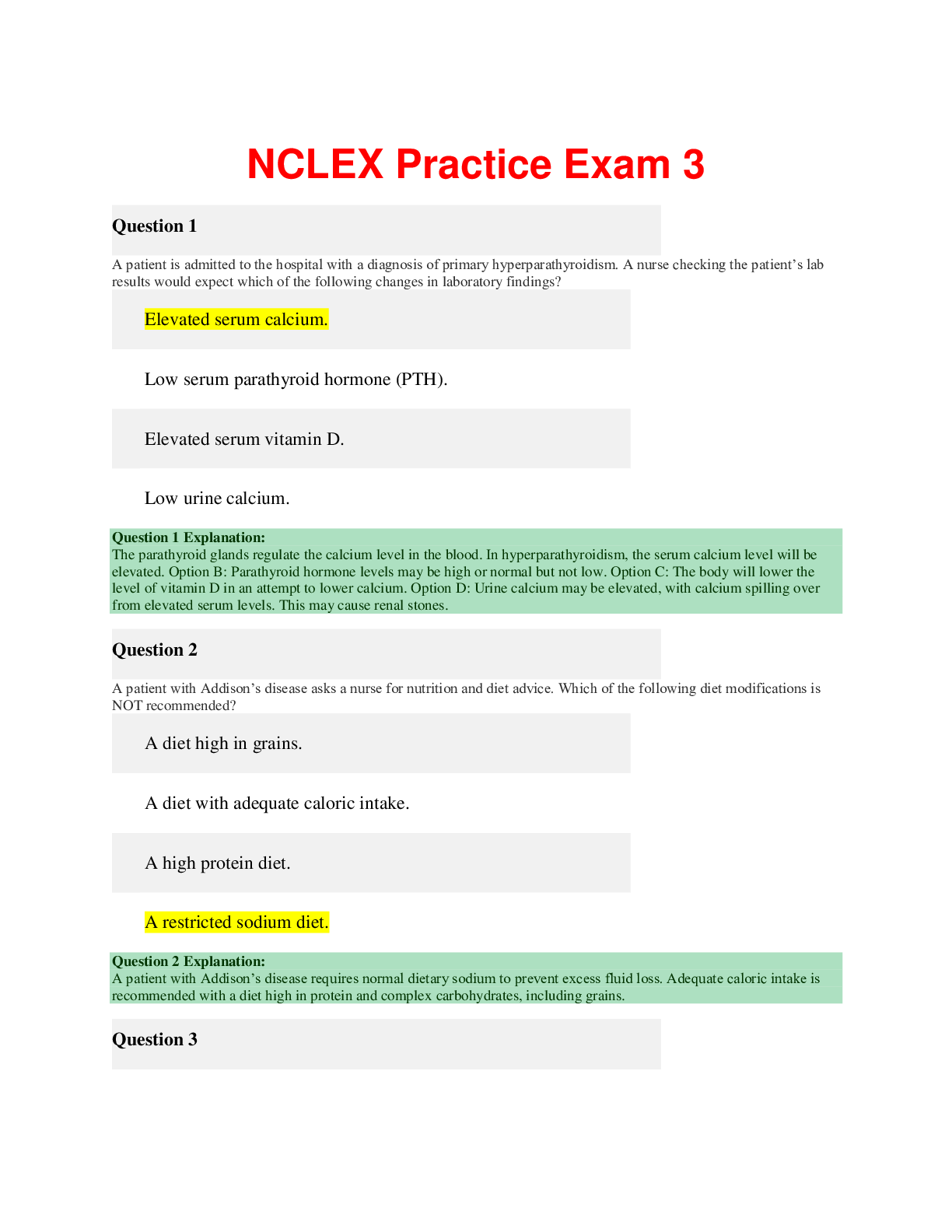
Buy this document to get the full access instantly
Instant Download Access after purchase
Add to cartInstant download
Reviews( 0 )
Document information
Connected school, study & course
About the document
Uploaded On
Sep 08, 2020
Number of pages
18
Written in
Additional information
This document has been written for:
Uploaded
Sep 08, 2020
Downloads
0
Views
39





.png)


